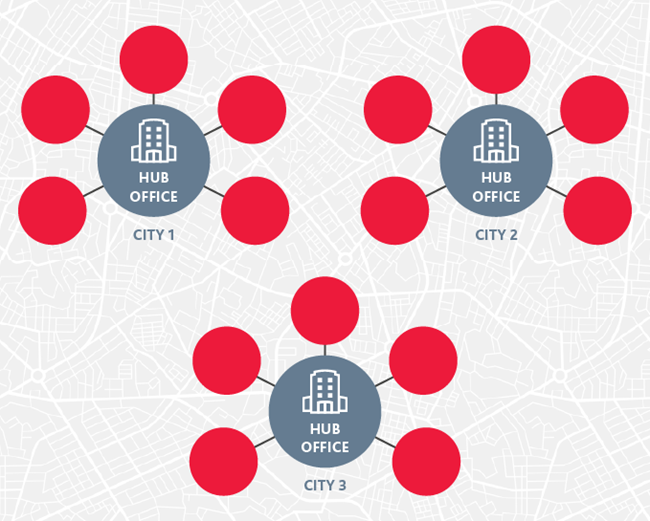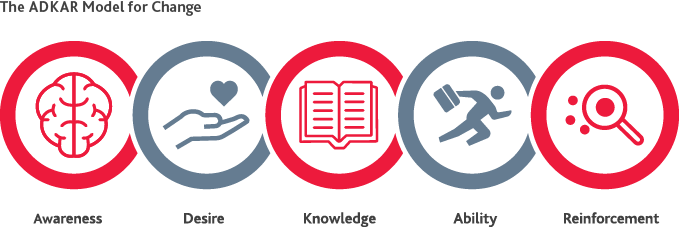Remote work capabilities have changed where we work; innovative technologies have changed how we work; and the push for more flexible schedules has changed when we work. In light of these recent shifts, there is significant financial risk, as well as loss of competitive advantage, in a return to ‘business as usual.’ Now is a great time to examine your company practices and implement bold changes that may have previously felt too radical or not urgent. Developing an agile workplace strategy can unlock value in multiple areas by increasing employee engagement, improving recruitment and retention, and improving operations in ways that bolster company-wide success.
What is an agile workplace strategy?
An agile workplace strategy focuses on how we work, not where, and results in processes that support that approach. The focus is on employees more than physical space. Organizations should closely examine the composition of their team(s) and recognize individual ways of working as well as generational differences. The strategy should extend far beyond remote working considerations, as these are just one facet of a larger agile workplace strategy.
The end goal is a workplace ecosystem that facilitates teamwork, collaboration and productivity without sacrificing operations. This can be achieved in various ways—through in-office adjustments, a work-from-anywhere model, or a hybrid approach—and it should be smart, intuitive and seamless. The methods will vary based on the type of business and industry, but the overall goal remains the same. Done well, an agile workplace strategy connects business needs with employee needs and builds in the flexibility to adapt as those needs evolve. Company leaders need to ensure workplace culture continues to be embraced, and that minimal loss of social connection occurs between teams or employees. Health and wellness are also a top priority.
The pandemic has exposed many areas where companies have failed to invest and adapt and motivated business owners to institute changes that may not have happened otherwise, or certainly not as quickly. Many leaders are realizing that they have not built up sufficient resilience or adequately planned for business continuity in the event of unexpected disruptions. Maintaining the status quo is not an option if you want to remain competitive and thrive.
What steps should you take toward an agile workplace strategy?
Step 1: Address the specific needs of your business and industry.
Your workplace strategy should encompass a holistic evaluation of where you are, where you want to go and what you need to get there. It should take into account the entire organization and your unique business and workforce needs, in order to identify the specific goals to achieve. It should include an implementation plan with actionable steps and measurable results. An effective strategy can increase resilience and improve operational performance, while also maximizing human capital through better employee engagement, satisfaction, productivity and retention.
Let’s review some outcomes that workplace strategy can help accomplish.
Employee retention and recruitment
Knowing what your employees want and how they work is an essential component of a flexible strategy. The workforce for most businesses is multi-generational, which poses challenges – how can employers meet the divergent needs of four generations of employees? Organizations that have agility and flexibility built in to their operations are better prepared to adapt to changing expectations and address the shifting needs of their workforce.
You must understand how changes impact the employee experience before you can determine if they are more efficient and effective. Ask your team key questions to learn more about shifting habits:
- What do you need to be successful?
- What are your preferences for a physical workspace?
- When are you ‘heads down?’ When are you socializing? When are you mobile?
- What environmental amenities prompt more productivity or creativity?
- How can we provide a healthy, safe work environment that addresses the physical and mental needs of employees?
A younger workforce may want mood lighting, a bar or more nature-oriented lounge areas, while a workforce that skews slightly older may prioritize sanitization and germ- or virus-killing technologies, as well as socially distanced work areas. How to best meet differing expectations should shape the strategy.
The broad shift to remote work, for those industries and companies that can implement it, has affected people differently depending on where they are in their careers. Younger professionals entering the workforce may be at a disadvantage for building a solid skills foundation and networking with peers, while those more advanced in their careers may need to juggle homeschooling their children and maintaining the output that management expects from them. Factoring in such challenges and working to address them can significantly boost employee engagement.
Any strategy should also focus on wellness and health, which can range from ensuring there is ample natural light and upgraded ventilation in the workplace to providing access to counseling onsite and/or via a telehealth interface. Especially during periods of disruption and uncertainty, upholding the mental health and overall well-being of employees is a necessary priority. Support that has been offered during the pandemic will likely set new expectations for workplace healthcare, so continuing to provide such support in the future can benefit the organization as a whole.
A smart workforce strategy accommodates the needs of professionals across a spectrum of demographics and preferences. Building a digitally-empowered workforce and mindset can provide a competitive edge on two fronts: It boosts employee retention and aids recruitment by broadening the talent pool substantially to include candidates in many different locations.
Cost control and liquidity management
When evaluating real estate, companies will need to have a more comprehensive justification for each location, determining what actual functions and work need to occur in an office and why. Focus on the purpose of the space – what specific functions will be occurring onsite versus in an alternative environment, for example? Occupancy cost as a percentage of revenue is significant for most organizations, and many businesses had to continue paying rent for offices or commercial space even if the space was only partially or entirely unoccupied during the pandemic, as contractual leasing obligations remained in place. This highlighted the need for greater real estate flexibility. While portfolio restructuring and lease auditing are among the strategies companies can pursue, remote work also has the potential to eliminate tremendous costs.
 The office of the future will likely reflect a hub-and-spoke model, where the hub is a centrally located office that acts as a cultural locus for the company and its employees. Satellite offices or co-working locations (the “spokes”) may offer areas to work according to specific company functions or requirements, thus reducing employees’ commutes to the hub and decreasing overall leasing obligations. Industry trends point to the possibility of a greatly reduced role of a corporate headquarters and more satellite or co-working spaces.
The office of the future will likely reflect a hub-and-spoke model, where the hub is a centrally located office that acts as a cultural locus for the company and its employees. Satellite offices or co-working locations (the “spokes”) may offer areas to work according to specific company functions or requirements, thus reducing employees’ commutes to the hub and decreasing overall leasing obligations. Industry trends point to the possibility of a greatly reduced role of a corporate headquarters and more satellite or co-working spaces.
Redefined purpose of space
Many executives are concerned that with the shift to remote work or hybrid work (a combination of in-office, remote and flexible working models), corporate culture and the kind of lively, interactive and spontaneous collaboration that occurred within shared office space will disappear. Mitigating the effects of these changes should be a pillar of your strategy.
Space-wise, the future will likely see a decrease in headcount, as fewer employees work from the office on a daily basis, along with a corresponding decrease in density to accommodate public health and social distancing practices. This raises many questions around the design and use of space:
- What should office floor plans look like if headcount and density both decrease?
- What should the ratio of collaborative to personal working spaces be?
- Should there be a central open floor plan oriented around collaboration for times that people meet in the office, with hoteling spaces around the periphery, or vice versa?
At the same time, companies need to consider how to extend work culture and amenities to the spokes, or satellite office locations. For employees working out of their homes or elsewhere, consider the extent to which you can support the workplace experience remotely and what amenities and technologies may be needed. This can help recreate the advantages of working from the office while affording the flexibility of working elsewhere.
Step 2: Bring the strategy to fruition
No business wants uncertainty, but in the current climate, uncertainty abounds. The businesses that foster agility and prepare accordingly will be best positioned to respond to changes in the market. This is the time for bold decisions, using what we do know to take advantage of market conditions while communicating a strong sense of direction and leadership to company customers and employees. Historical data and insights are key components to forecasting an organization’s projected real estate needs. What will your future leasing obligations look like? Building an accurate forecast for this can help devise a strategy that both controls costs and increases agility.
Assess your physical space(s), identifying areas of potential savings in the near term, and consider opportunities for long-term savings. For near-term changes with leased facilities, tenants will typically see greater success by working with landlords as partners to negotiate an ideal outcome (e.g., operating expense reductions for unoccupied or partially occupied space, temporary rent relief, etc.). Any locations with near-term lease expirations should be examined carefully for historical occupancy, costs, profitability and projected future needs. Options include a short-term extension, lease termination or possible restructuring. Any recent changes in occupancy and utilization can help inform decision making, and ongoing scenario planning will help weave flexibility into the long-term workplace strategy.
To support organizational agility, it’s also best practice to review, update and test the business continuity plan and incident response plan, and then ensure there is a dedicated incident management team composed of key stakeholders from across the organization. It’s useful to have visibility into the business continuity plans of important suppliers and third-party vendors as well. Additional steps to increase agility on a continual basis include:
- Cross-training and upskilling to boost workforce agility in case of personnel changes
- Ongoing training for all digital communication and collaboration platforms
- Clarifying processes for remote work, including mobile device management and a BYOD (Bring-Your-Own-Device) policy
Change starts at the top, so executives and management need to champion the changes and collaborate to facilitate firmwide success. Businesses should build their communication plan and change management plan to accomplish specific objectives, and using the ADKAR model helps establish change across the organization:
- Awareness of the reasons why changes are needed
- Desire to support the changes
- Knowledge of how to accomplish the changes
- Ability and skills to implement the changes
- Reinforcement to help drive change adoption

Through scenario planning, forecasting and change management, businesses can reduce uncertainty by building agility and resilience into critical assets for the future. Through this, leaders can better harness data-driven insights and unlock value for the organization in a strategic, holistic manner.
Building agility for the future
Simply allowing remote work does not make for an agile workplace strategy. Diligent analysis and deliberate planning are needed to build agility into a company’s DNA. An internal assessment of these key aspects, combined with scenario planning, is the first step on your workplace strategy journey. Bringing the strategy to fruition will happen in planned stages over time according to the unique needs of your business.
The trend toward flexibility was already gaining momentum before the pandemic, but now businesses have the opportunity to execute on changes that may have once seemed out of reach.


